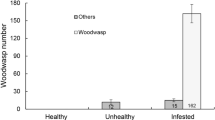Abstract
Relationships between tree mortality and bark beetle infestation onAbies veitchii at the wave-regenerated forest in Mt. Asahi, Okuchichibu area were investigated. Most of the firs with green needles and newly developed current year’s shoots in the dieback zone were heavily infested by bark beetles before the death of the trees. After heavy infestation of beetles, about half of the infested firs died within the year, and the other half died in the next year. When the species composition of bark beetles and associated ophiostomatoid fungi were investigated in Mt. Asahi and also at a typical wave-regenerated forest in Mt. Shimagare, Yatsugatake area,Cryphalus montanus andC. piceae were dominant beetle species for Mt. Asahi and Mt. Shimagare, respectively.Ophiostoma subalpinum andO. europhioides were dominant fungal species at both wave-generated forests. BecauseO. subalpinum was detected more frequently from deeper areas of sapwood thanO. europhioides, it was suggested that the fungal species may accelerate the death of stressed firs in wave-regenerated forests.
Similar content being viewed by others
Literature cited
Brasier, C.M. (1991)Ophiostoma novo-ulmi, causative agent of the current Dutch elm disease pandemics. Mycopathologia 115: 151–161.
Cerchiarini, F. and Tiberi, R. (1997)Cryphalus piceae and silver fir decline in Vallombrosa forest.In Proceedings of integrating cultural tactics into the management of bark beetle and reforestation pests. Grégorie, J.C., Liebhold, A.M., Stephen, F.M., Day, K.R., and Salom, S.M. (eds.), USDA Forest Service General Technical Report NE-236, 217–219.
Foster, J.R. (1988) The potential role of rime ice defoliation in tree mortality of wave-regenerated balsam fir forests. J. Ecol. 76: 172–180.
Gibbs, J.N. (1993) The biology of ophiostomatoid fungi causing sapstain in trees and freshly cut logs.In Ceratocystis andOphiostoma, taxonomy, ecology, and pathogenicity. Wingfield, M.J., Seifert, K.A., and Webber, J.F. (eds.), 293pp., The American Phytopathological Society Press, St. Paul, Minnesota, 153–160.
Harrington, T.C. (1988)Leptographium species, their distributions, hosts and insect vectors.In Leptographium root diseases on conifers. Harrington, T.C. and Cobb, F.W., Jr. (eds.), 149pp, The American Phytopathological Society Press, St. Paul, Minnesota, 1–39.
Iwaki, H. and Totsuka, T. (1959) Ecological and physiological studies on the vegetation of Mt. Shimagare. II. On the crescent-shaped “Dead Trees Stripes” in the Yatsugatake and the Chichibu Mountains. Bot. Mag. Tokyo 72: 255–260.
Lagerberg, T., Lundberg, G., and Melin, E. (1927) Biological and practical researches into bluing in pine and spruce. Sv. Skogsvardsf. Tidskr. 25: 145–272.
Marchand, P.J., Goulet, F.L., and Harrington, T.C. (1986) Death by attrition: A hypothesis for wave mortality of subalpineAbies balsamea. Can. J. For. Res. 16: 591–596.
Maruta, E. and Nakano, T. (1999) The effects of environmental stresses on conifers in the subalpine area of the central Japan. Jpn. J. Ecol. 49: 293–300. (in Japanese)
Ohtaka, N., Masuya, H., Kaneko, S., and Yamaoka, Y. (2002) TwoOphiostoma species associated with bark beetles in wave-regeneratedAbies veitchii forests in Japan. Mycoscience 43: 151–157.
Oshima, Y., Kimura, M., Iwaki, H., and Kuroiwa, S. (1958) Ecological and physiological studies on the vegetation of Mt. Shimagare. I. Preliminary survey of the vegetation of Mt. Shimagare. Bot. Mag. Tokyo 71: 289–301.
Paine, T.D., Raffa, K.F., and Harrington, T.C. (1997) Interactions among scolytid bark beetles, their associated fungi, and live host conifers. Ann. Rev. Entomol. 42: 179–206.
Seifert, K.A. (1993) Sapstain of commercial lumber by species ofOphiostoma andCeratocystis.In Ceratocystis andOphiostoma, taxonomy, ecology, and pathogenicity. Wingfield, M.J., Seifert, K.A., and Webber, J.F. (eds.), 293pp, The American Phytopathological Society Press, St. Paul, Minnesota, 141–151.
Solheim, H. (1995) Early stages of blue-stain fungus invasion of lodgepole pine sapwood following mountain pine beetle attack. Can. J. Bot. 73: 70–74.
Sprugel, D.G. (1976) Dynamic structure of wave-regeneratedAbies balsamea forests in the north-eastern United States. J. Ecol. 64: 889–911.
Tadaki, Y., Sato, A., Sakurai, S., Takeuchi, I., and Kawahara, T. (1977) Studies on the production structure of forest. XVIII. Structure and primary production in subalpine “dead tree strips”Abies forest near Mt. Asahi. Jpn. J. Ecol. 27: 83–90. (in Japanese with English summary)
Yamaoka, Y., Hiratsuka, Y., and Maruyama, P.J. (1995) The ability ofOphiostoma clavigerum to kill mature lodgepole pine trees. Eur. J. For. Pathol. 25: 401–404.
Yamaoka, Y., Swanson, R.H., and Hiratsuka, Y. (1990) Inoculation of lodgepole pine with four blue-stain fungi associated with mountain pine beetle, monitored by a heat pulse velocity (HPV) instrument. Can. J. For. Res. 20: 31–36.
Yamaoka, Y., Wingfield, M.J., Takahashi, I., and Solheim, H. (1997) Ophiostomatoid fungi associated with the spruce bark beetleIps typographus f.japonicus in Japan. Mycol. Res. 101: 1215–1227.
Author information
Authors and Affiliations
Corresponding author
Additional information
Contribution No. 169, Laboratory of Plant Parasitic Mycology, Institute of Agriculture and Forestry, University of Tsukuba.
About this article
Cite this article
Ohtaka, N., Masuya, H., Kaneko, S. et al. Ophiostomatoid fungi associated with bark beetles onAbies veitchii in wave-regenerated forests. J For Res 7, 145–151 (2002). https://doi.org/10.1007/BF02762603
Received:
Accepted:
Issue Date:
DOI: https://doi.org/10.1007/BF02762603




